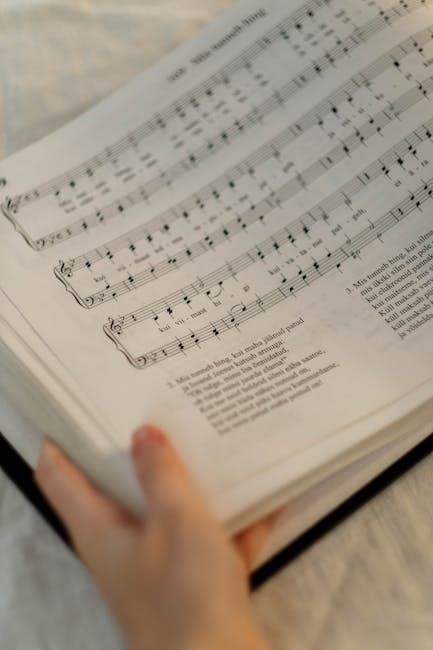
The Hallelujah Score PDF offers a comprehensive musical arrangement of Leonard Cohen’s iconic song, providing sheet music for piano and vocals in a clear, downloadable format.
1.1 Overview of the Song “Hallelujah”
Hallelujah is a timeless masterpiece by Leonard Cohen, known for its emotional depth and poetic lyrics. The song’s versatility allows it to transcend genres, making it a favorite for artists and musicians worldwide. Its haunting melody and complex chord progression have been interpreted in countless ways, from Jeff Buckley’s iconic version to piano-driven arrangements. The song’s themes of love, spirituality, and human connection resonate universally, captivating audiences for decades. Available in various formats, including PDF sheet music, Hallelujah remains a staple for pianists and vocalists, offering both challenges and creative expression for musicians of all skill levels.
1.2 Importance of Sheet Music in Music Performance
Sheet music is an essential tool for musicians, providing a structured blueprint for performance. It ensures accuracy and consistency, allowing artists to interpret compositions faithfully. For Hallelujah, sheet music offers clarity on complex chord progressions and melodies, making it accessible for pianists and vocalists. Whether in PDF or other formats, sheet music serves as a reliable guide, enabling musicians to master the piece. It also fosters creativity, as performers can adapt the score to suit their style. With resources like MIDI files and digital tools, sheet music enhances learning and performance, making it indispensable for both professionals and beginners.
1.3 Why “Hallelujah” Remains a Popular Choice for Musicians
Hallelujah continues to captivate musicians due to its timeless appeal and versatility. Its rich, emotional lyrics and haunting melody make it a favorite across genres. The song’s complex chord progressions and poetic depth offer endless interpretative possibilities, attracting pianists and vocalists alike. Performances by legendary artists like Jeff Buckley and Leonard Cohen have further cemented its status. Additionally, the availability of Hallelujah in various formats, including PDF sheet music, has made it accessible to a wide range of musicians. Its adaptability for solo, duet, and choral arrangements ensures its enduring popularity in modern music.

The Background of “Hallelujah”
Hallelujah, written by Leonard Cohen, has a rich history rooted in poetic and musical innovation. Its creation spans years, reflecting Cohen’s spiritual and emotional journey, making it timeless.
2.1 Leonard Cohen: The Creator of “Hallelujah”
Leonard Cohen, a renowned Canadian singer, songwriter, and poet, is the mastermind behind the iconic song Hallelujah. Written in the 1980s, the song was first released in 1984 on Cohen’s album Various Positions. Known for its profound lyrics and emotional depth, Hallelujah reflects Cohen’s poetic brilliance and spiritual exploration. Over the years, Cohen crafted over 80 verses, showcasing the song’s complexity and versatility. Its enduring popularity stems from its universal themes of love, faith, and human connection. Despite Cohen’s passing in 2016, Hallelujah remains a testament to his artistic legacy, continuing to inspire musicians and audiences worldwide.
2.2 Historical Context and Inspiration Behind the Song
Hallelujah was written by Leonard Cohen in the early 1980s, influenced by his deep exploration of spirituality, love, and existential themes. The song’s lyrical richness reflects Cohen’s poetic mastery and philosophical inquiries. Drawing from biblical references, personal experiences, and emotional struggles, Hallelujah captures a universal resonance. Initially met with limited acclaim, it gained prominence through covers, particularly Jeff Buckley’s haunting rendition. Cohen’s meticulous craftsmanship, evident in its multiple verses, underscores his perfectionism. The song’s timeless appeal lies in its ability to transcend genres, blending the sacred and the secular into a powerful emotional tapestry. Its legacy endures as a testament to Cohen’s artistic genius and enduring influence on music.
2.3 Evolution of “Hallelujah” Over the Years
Since its release in 1984, Hallelujah has undergone remarkable transformations, becoming a timeless classic. Originally written by Leonard Cohen, the song gained widespread recognition through Jeff Buckley’s iconic 1994 cover, which introduced it to a new generation. Over the years, numerous artists have reimagined the track, infusing it with diverse styles, from classical to rock. Its versatility has led to over 300 recorded versions, each offering a unique interpretation. The song’s emotional depth and poetic lyrics continue to inspire musicians and audiences alike. Its evolution reflects its universal appeal, transcending genres and generations, solidifying its place in musical history. This enduring legacy highlights its profound impact.

Sheet Music Availability and Formats
Hallelujah sheet music is widely available online in PDF format, with both free and paid versions. MIDI files and digital tools also accompany the scores, catering to diverse musical needs. Popular formats include piano scores, vocal arrangements, and easy piano versions, ensuring accessibility for musicians of all skill levels. Many websites offer high-quality downloads, making it easy to find the perfect arrangement for performance or practice. This versatility ensures that Hallelujah remains a favorite among pianists and vocalists worldwide. The PDF format is particularly favored for its clarity and convenience.
3.1 Where to Find “Hallelujah” Sheet Music Online
Musicians can find Hallelujah sheet music online through platforms like Musicnotes and Sheet Music Plus, which offer both free and paid versions. Scribd provides user-uploaded content, including PDFs, while MuseScore features community-shared arrangements. Official sources, such as Leonard Cohen’s publisher or Sony/ATV Music Publishing, ensure legal and high-quality downloads. Additionally, websites like 8notes and Piano Nanny may have versions available. Always prioritize reputable sites to avoid pirated content and support artists and creators.
3.2 Free vs. Paid Versions: What’s the Difference?
Free versions of Hallelujah sheet music, often found on platforms like MuseScore or Scribd, may include basic arrangements or partial scores. These are ideal for casual use or previews. Paid versions, available on sites like Musicnotes or Sheet Music Plus, offer high-quality, officially licensed arrangements, including full scores, piano accompaniments, and vocal parts. Paid sheets are professionally formatted, ensuring accuracy and completeness. Free versions may lack dynamics, fingerings, or detailed notation, while paid versions provide polished, performance-ready materials. Additionally, purchasing supports the creators and ensures legal compliance, making it the preferred choice for serious musicians;
3.3 PDF Format Advantages for Musicians
The PDF format offers numerous advantages for musicians using Hallelujah sheet music. PDFs maintain consistent formatting and clarity across devices, ensuring proper display of musical notation. They are portable, allowing easy access on tablets, laptops, or mobile devices, ideal for rehearsals or performances. PDFs are also secure, often including copyright protection to prevent unauthorized distribution. Their scalability ensures readability on various screen sizes, and they support interactive features like bookmarks and annotations. Additionally, PDFs are widely compatible with both free and paid software, making them accessible to all musicians. These features make PDFs a reliable and versatile choice for sheet music.

Piano Arrangements of “Hallelujah”
The song offers versatile piano arrangements, including solo, duet, and simplified versions, catering to musicians of all skill levels with rich harmonic and melodic depth.
4.1 Solo Piano Arrangements
The solo piano arrangements of “Hallelujah” offer a stripped-down yet powerful interpretation, emphasizing the song’s emotional depth through intricate melodies and harmonies. These arrangements are ideal for pianists seeking to showcase their technical and expressive skills. Available in various formats, including PDF and MIDI, they provide flexibility for both performance and practice. Musicians can explore arrangements tailored to different skill levels, from simplified versions for beginners to complex renditions for advanced players. The solo piano format allows for a intimate connection with the music, highlighting Leonard Cohen’s poetic lyrics and timeless composition. This versatility makes “Hallelujah” a cherished piece among pianists worldwide.
4.2 Piano Duet Arrangements
Piano duet arrangements of “Hallelujah” bring a new dimension to the song, allowing two pianists to collaborate and create a rich, layered sound. These arrangements often feature complementary melodies and harmonies, enhancing the emotional complexity of the piece; Available in formats like PDF and MIDI, duet scores provide a versatile way for musicians to practice and perform together. Whether for professional collaboration or casual enjoyment, piano duet versions of “Hallelujah” offer a unique way to experience Leonard Cohen’s timeless classic. The interplay between the two pianos adds depth and texture, making it a popular choice for both advanced players and amateur duets.
4.3 Easy Piano Versions for Beginners
Easy piano versions of “Hallelujah” are tailored for beginners, simplifying the iconic song’s complex melodies and chord progressions. These arrangements focus on basic techniques, making the piece accessible to those with limited experience. Featuring simplified chord structures and slower tempos, these versions allow new pianists to learn and perform confidently. Many PDF scores include clear notation and fingerings, guiding learners through the music. Additionally, some versions combine piano and vocal parts, offering a holistic approach. These adaptations ensure that even beginners can enjoy playing “Hallelujah” while developing their skills. They are a great starting point for mastering this beloved classic.

Vocal and Instrumental Combinations
Vocal and instrumental combinations enhance “Hallelujah’s” emotional depth, offering rich layers of sound. From piano and vocal duets to orchestral arrangements, these blends create a versatile performance experience.
5.1 Piano and Vocal Scores
The piano and vocal scores of “Hallelujah” provide a harmonious blend of melody and lyrics, making it a popular choice for both singers and pianists. These scores are widely available in PDF format, offering clear notation for vocal parts and piano accompaniments. Many arrangements include chord progressions, dynamics, and expression markings to guide performers. Some versions feature additional instrumental cues, enhancing the song’s emotional depth. Whether for solo performances or collaborative efforts, these scores ensure a balanced and impactful delivery of Cohen’s timeless lyrics. Musicians can find both free and paid versions online, catering to various skill levels and interpretive styles, making “Hallelujah” accessible to all.
5.2 Instrumental Accompaniments
Instrumental accompaniments for “Hallelujah” enrich the song’s emotional depth, offering musicians diverse ways to enhance performances. Scores often include arrangements for strings, guitars, and woodwinds, complementing the piano and vocals. These accompaniments are available in PDF format, accessible for download from various online sources. While the piano version remains the most popular, instrumental additions provide layers of complexity, allowing for creative interpretations. Whether for a solo performance or a full ensemble, these accompaniments expand the song’s versatility, making it suitable for various musical settings and enabling artists to explore new dimensions of Cohen’s timeless classic.
5.3 Choral Arrangements of “Hallelujah”
Choral arrangements of “Hallelujah” offer a harmonious and powerful way to experience Leonard Cohen’s masterpiece. Available in PDF format, these arrangements are ideal for choirs and vocal ensembles, adding layers of depth and emotion to the song. Many choral versions maintain the original melody while incorporating rich harmonies, making them suitable for both sacred and secular performances. Websites like Scribd and other sheet music platforms provide access to these arrangements, allowing groups to explore Cohen’s timeless lyrics in a collective setting. Whether for a grand concert or an intimate gathering, choral adaptations of “Hallelujah” continue to inspire and captivate audiences worldwide.

Legal Aspects of Using “Hallelujah” Sheet Music
Using “Hallelujah” sheet music requires adherence to copyright laws. Ensure proper licensing from Sony/ATV Music Publishing to avoid legal consequences. Always use authorized PDF sources for compliance.
6.1 Copyright Laws and Licensing
Using “Hallelujah” sheet music requires compliance with copyright laws. The song, written by Leonard Cohen, is owned by Sony/ATV Music Publishing. To legally use the score, musicians must obtain proper licensing. Unauthorized use of copyrighted material, including PDF downloads from unverified sources, constitutes infringement. Licensing ensures fair compensation for the creators and publishers. Platforms like Musicnotes and Sheet Music Plus offer legally licensed versions. Violating copyright laws can result in legal consequences, including fines. Always verify the source of your sheet music to ensure it is authorized and compliant with copyright regulations.
6.2 Fair Use and Educational Exceptions
Fair use permits limited use of copyrighted material without permission, particularly for education or commentary. Educators and students may use Hallelujah sheet music for teaching or analysis. However, this exception doesn’t cover commercial use or distributing unauthorized copies. For educational purposes, portions of the score can be shared, but complete PDF downloads from unlicensed sources remain illegal. Always verify the source’s legitimacy. Consulting the copyright holder or legal expert is advised for specific cases to ensure compliance. This balance protects creators’ rights while fostering educational and artistic growth.
6.3 Consequences of Using Pirated Sheet Music
Using pirated Hallelujah sheet music can lead to legal consequences, including fines and lawsuits. Copyright infringement violates intellectual property laws, with penalties ranging from monetary damages to court action. Additionally, downloading from unverified sources risks malware exposure. Supporting piracy undermines artists and publishers, reducing revenue for future creations. Legal alternatives are available to access Hallelujah scores ethically, ensuring both compliance and artist support. Always prioritize licensed sources to avoid legal and security issues while respecting the rights of creators like Leonard Cohen.

Tips for Learning “Hallelujah” on Piano
- Start with the chord progression to build a strong foundation.
- Practice complex sections slowly, focusing on precise finger placement.
- Emphasize dynamics to enhance emotional expression in the melody.
7.1 Understanding the Chord Progression
Mastering the chord progression is essential for playing Hallelujah. The song revolves around a sequence of minor and major chords, creating a hauntingly beautiful melody. Starting with C Major, the progression moves through A minor, F Major, and G Major, forming a harmonic foundation. Understanding these transitions is crucial for maintaining the song’s emotional depth. Using the Hallelujah Score PDF, pianists can follow the chord notation, ensuring accuracy and fluency. This structure allows for creative interpretation while staying true to Leonard Cohen’s timeless composition. Regular practice will help musicians internalize the progression, enabling a smoother performance.
7.2 Practicing Techniques for Complex Sections

Mastering complex sections of Hallelujah requires focused practice. Break down challenging parts into smaller segments, practicing each slowly before combining them. Use a metronome to maintain tempo consistency. Emphasize dynamics and expression to capture the song’s emotional depth. Repeat difficult passages multiple times until they feel natural. Gradually increase speed as confidence grows. Utilize the Hallelujah Score PDF to visualize chord progressions and finger placements. Record yourself to identify areas for improvement. Incorporate pedaling techniques for a richer sound. Regular, patient practice will help musicians conquer intricate sections and deliver a compelling performance of this timeless piece.
7.3 Incorporating Dynamics and Expression
Incorporating dynamics and expression is essential for a compelling performance of Hallelujah. The Hallelujah Score PDF provides clear markings for crescendos, decrescendos, and phrasing. Musicians should focus on varying dynamics to reflect the song’s emotional depth, using softer tones for introspective verses and swelling for powerful choruses. Pay attention to fermatas and ritardandos to emphasize key lyrical moments. Expression can be enhanced by subtle tempo variations and nuanced pedaling. Listening to iconic versions, like Jeff Buckley’s, can inspire interpretative approaches. Balancing technical accuracy with emotional delivery ensures a captivating rendition of this timeless piece.

Resources for Musicians
Discover high-quality Hallelujah sheet music, MIDI files, and digital tools online. Websites like Musicnotes and Scribd offer Piano and Vocal scores in PDF format for download, aiding musicians in perfecting their performance.
8.1 Websites Offering High-Quality Sheet Music
Several websites provide high-quality Hallelujah sheet music, including Musicnotes, Scribd, and SheetMusicPlus. These platforms offer PDF downloads with clear notation for Piano and Vocal arrangements. Many sites feature user-friendly interfaces, allowing musicians to preview and purchase scores easily. Some offer free samples or previews, enabling artists to assess the quality before downloading. These resources are invaluable for both professionals and amateurs seeking accurate and well-formatted sheet music to perfect their performances of Leonard Cohen’s timeless classic.
8.2 MIDI Files and Digital Tools
MIDI files and digital tools enhance the learning and performance of Hallelujah. Websites like MIDIWorld and Piano Nanny offer downloadable MIDI files, allowing musicians to practice with adjustable tempos and explore arrangements. Apps like Synthesia and MuseScore support MIDI, enabling interactive learning. Digital tools provide layering and looping features, making complex sections manageable. These resources are invaluable for both practice and performance, offering flexibility and depth to musicians mastering Leonard Cohen’s timeless song.
8.3 Online Communities and Forums
Online communities and forums are invaluable for musicians seeking support and resources. Platforms like Reddit (e.g., r/piano or r/music) and specialized music forums offer spaces to discuss Hallelujah arrangements, share tips, and connect with fellow musicians. These communities often feature threads dedicated to sheet music recommendations, performance advice, and interpretations of the song. Additionally, Facebook groups and Discord servers focused on piano or vocal music provide collaborative environments for learning and feedback. Engaging with these forums can help musicians discover rare or unique arrangements and gain insights from experienced performers, fostering growth and creativity in their musical journey.

Notable Performances and Covers
Jeff Buckley’s rendition of Hallelujah is widely acclaimed, while covers by John Cale and Rufus Wainwright highlight the song’s timeless appeal, inspiring countless musicians to reinterpret it.
9.1 Jeff Buckley’s Iconic Version
Jeff Buckley’s rendition of Hallelujah is arguably the most famous cover, transforming Leonard Cohen’s song into a hauntingly beautiful masterpiece. Buckley’s emotional delivery and soaring vocals captivated audiences, making his version a timeless classic. His interpretation, featured on the 1994 album Grace, is widely regarded as one of the greatest song covers in music history. Buckley’s ability to convey vulnerability and intensity brought new depth to the lyrics, resonating deeply with listeners. His version has been praised for its raw emotion and artistic brilliance, solidifying its place as a staple in modern music. It continues to inspire musicians and remains a benchmark for interpreting Cohen’s masterpiece.
9.2 Other Famous Covers and Interpretations
Beyond Jeff Buckley’s iconic version, Hallelujah has been reimagined by numerous artists, each bringing their unique style to the timeless classic. John Cale’s slower, more intimate interpretation emphasizes the song’s emotional depth, while Rufus Wainwright’s orchestral arrangement adds a lush, cinematic quality. Pentatonix delivered a stunning a cappella rendition, showcasing vocal harmonies and creativity. Other notable covers include performances by k.d. lang, whose powerful vocals highlight the song’s spiritual essence, and Alexandra Burke, who infused it with a contemporary pop feel. These diverse interpretations underscore the song’s versatility and enduring appeal, allowing it to resonate with audiences across generations and genres. Each artist’s take on Hallelujah further cements its status as a modern musical treasure.
9.3 Influence of “Hallelujah” on Other Artists
Leonard Cohen’s Hallelujah has profoundly influenced countless musicians, inspiring reinterpretations and shaping songwriting styles. Its poetic depth and soaring melody have made it a benchmark for emotional expression. Many artists, including Jeff Buckley and John Cale, have credited the song as a source of inspiration, incorporating its lyrical complexity and musical structure into their own work. The track’s versatility has also encouraged experimentation across genres, from classical to rock, proving its timeless appeal. Its impact is evident in modern music, with numerous artists referencing or covering it, ensuring its legacy endures as a masterpiece of contemporary songwriting.
Hallelujah remains a timeless masterpiece, its emotional depth and versatility inspiring musicians and audiences alike. Its enduring appeal lies in its universal themes and adaptability, ensuring its place in modern music history.
10.1 Final Thoughts on the Significance of “Hallelujah”
Hallelujah is more than a song; it’s a timeless masterpiece that transcends generations. Its emotional depth, poetic lyrics, and haunting melody create a universal connection with listeners. The availability of Hallelujah score PDF has made it accessible to musicians worldwide, allowing interpretations across genres and instruments. The song’s versatility is evident in its countless covers, from Jeff Buckley’s iconic version to classical piano arrangements. Its enduring popularity underscores its ability to evoke emotions and inspire creativity. Whether performed solo or with accompaniments, Hallelujah remains a cornerstone of modern music, continuing to captivate audiences and musicians alike with its profound beauty and timeless appeal.
10.2 Encouragement for Aspiring Musicians
Aspiring musicians, embrace the timeless appeal of Hallelujah as a perfect piece for exploration and growth. With its rich, emotional depth and versatility, this song offers endless opportunities for interpretation. Whether you’re mastering the piano, refining your vocal technique, or experimenting with new arrangements, Hallelujah provides a foundation to showcase your talent. Take advantage of the readily available Hallelujah score PDF, which includes sheet music for piano, vocals, and even MIDI files, to guide your practice. Remember, every great musician starts with a piece that resonates deeply. Let Hallelujah inspire you to connect with its lyrics and melody, allowing your unique voice to shine through.
10.3 The Timeless Appeal of “Hallelujah” in Modern Music
Hallelujah remains a cornerstone of modern music, captivating audiences across generations. Its enduring appeal lies in the emotional depth and universal themes of love, spirituality, and human connection. The availability of Hallelujah score PDF ensures that musicians can easily access and interpret this masterpiece, keeping it relevant in today’s musical landscape. From piano solos to choral arrangements, the song’s versatility allows it to evolve while maintaining its essence. Aspiring artists continue to draw inspiration from its timeless melody and poetic lyrics, making Hallelujah a timeless classic that transcends genres and decades, ensuring its place in the hearts of music lovers worldwide.